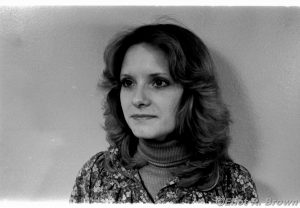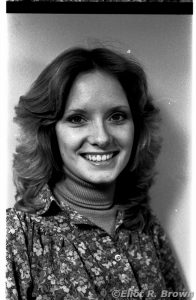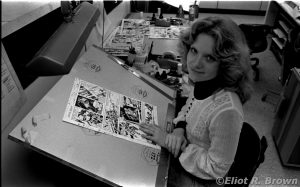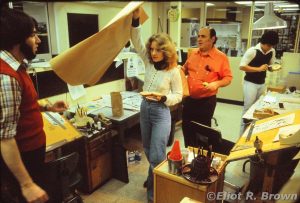The first thing that should be known about Elaine is that she—and Ron Zalme (and Steve Bissette but he can talk about his own gigantic career!)—were the first graduates from The Kubert School.
The time was 1976 and the “where” was Marvel Editorial offices at 575 Madison Avenue. The Marvel line was expanding (and so was Danny’s waist line…). The Kubert School was started by (truly) legendary artist and creator, Joe Kubert. One can only guess he knew there might be a need for a degree of “professionalism” called for by the various comic companies. Prior, hoboes and drifters had taken several seats in the Bullpen (-s of all comic entities). They did okay; but there was room for dentistry.
The call went out for Production people. The Kubert School trained people, boot-camp style. 0600 you sharpened Hunt 107 steel nibs, 0720 you had your dry doughnut for breakfast, 0800 you practiced illegible instructions for the stat department (“I can still read this! Take it back!”). Etc.! You learned the difference between Strathmore and Bainbridge [Kubert’s Legal Department! – “Counselor” Brown]
Most importantly, you had an idea of what a comic page looked like. For those of you who have never seen a “real” comic page, it’s different than what you might expect. It’s such a beautiful, high contrast thing, it already looks printed. And it’s tough, you’d be surprised how much you can hack and scratch at it with perfectly printable results. And you learn that degree of rough-housing at Kubert’s.
But I digress. The Kubert School also featured lectures by many working pros and Creators. Still working hard turning out pro-grade talents to this very day.
Including one Elaine Heinl.
This shot could be taken on Graduation Day, kind’a has that vibe, y’know… looking towards tomorrow…
Elaine had been on staff for almost a year by the time I came on in late 78. What I did not know was that she was a veteran of Letterer Extradornaire, the late, Jim Novak, having blasted onto the lettering firmament! Wielding the short nib-holders like lances, everyone did battle with Jim as he made use of ellipse templates to make “perfect” word balloons. None of which I knew about till only recently.
Now listen up out there—this sort of thing is IMPORTANT, get me? Using an ellipse template instead of just drawing that shape free-hand was nothing short of earth shattering. Friendships ended, fist-fights—FOOD fights in the Bullpen… Anarchy.
Thus, when Elaine came back to my stat-camera office and asked for a copy of some lettering so she could re-do a word balloon shape, the old draftsman in me smiled and I offered the advice of using an ellipse template.
Happier times and not an ellipse template in sight!
What is an ellipse template? One of the harder things to draw neatly is an ellipse. Take an up-down line and a left-right line crossing in the middle of a circle. Where they meet is the center. From that point to the circumference is equal all around. In the ellipse’s case, those two lines (axis) are not. If you take something circular, put it on a table, close one eye and rest your open eye on the same table, then tilt the circle to any degree, say 30°, you will see a roundy shape that is a 30° ellipse.
A template of such things is a sheet of plastic organized by size and degree of tilt. Run a pencil or pen around the inside and whammo! You have a perfect ellipse shape. No wonder Novak caused a ruckus.
To the World of Comic Readers, the words appear as if by magic. They’re right there on the page, coming from a character’s mouth. The placing of that little bit of magic is an art. An art form—with no little amount of talent needed. Can it be done badly? Sure, my own attempts at lettering are good examples. When it is done well, the character is more alive, the words fairly form in a readers’ mind and you are not aware of “reading.”
Elaine had the eye-to-hand coordination and basic art skill to do a very good job. There I was, telling her to get with it and use an instrument to stamp-out those word balloons.
Production Workers Joe Albelo, Elaine Heinl, Glorious Production Leader Danny Crespi—bringing up the rear bagel is John Romita Jr who was a correction artist in the Black & White Department and no stranger to free bagels! Early 1979. Above, I believe Elaine is using a handy piece of brown paper to wrap up her bagels for later. Nothing wrong with being securely wrapped.
When I made my suggestion to Elaine about using a template, there it was… that familiar crystalizing-over of the feminine face. Her calmly worded reply was that the balloon shape needed to be done… with… a… pen. Then she turned as if on wheels and skimmed out of my office and down the hall.
Not long after—perhaps mid-1979– she moved on to what heights only she knows…
Now, some 40+ years later, when I reached her and spoke to her, as soon as I mentioned my name the same icy layer appeared. There was some claim of needing to take care of “grandchildren” so that’s a hopeful sign. Then another familiar clang of a violent hanging up of the phone. The “Template Controversy” still rages for some…




Scene: The nerve center of Rick and Ralph (Macchio)’s office. We had the enormous window looking out, over the Xerox machine, to the Marvel universe known as the bullpen. Among its denizens, Elaine Heinl and Davida Lichter-Dale. How DID we get any of our books out…?
Good profile, El. Of course.
As expected another whimsical and historical story form the legendary 70’s food fight Marvel bullpen. Love the side explanations of the legendary (old school) art supplies.
You have brought more smiles to my face yet again.
Thnx!
Glad to do that, Len– you will be coming up soon.